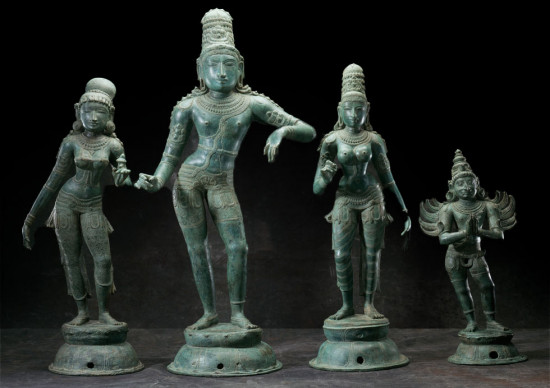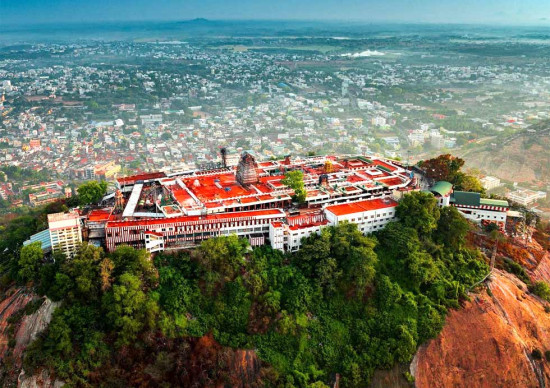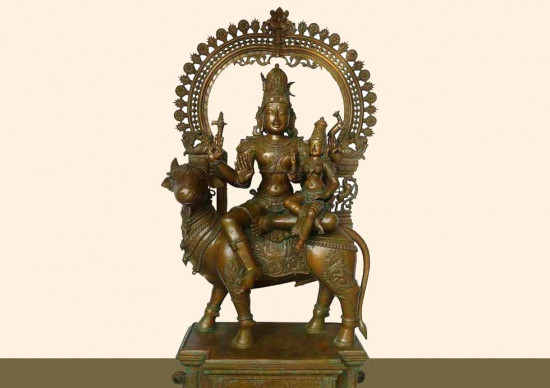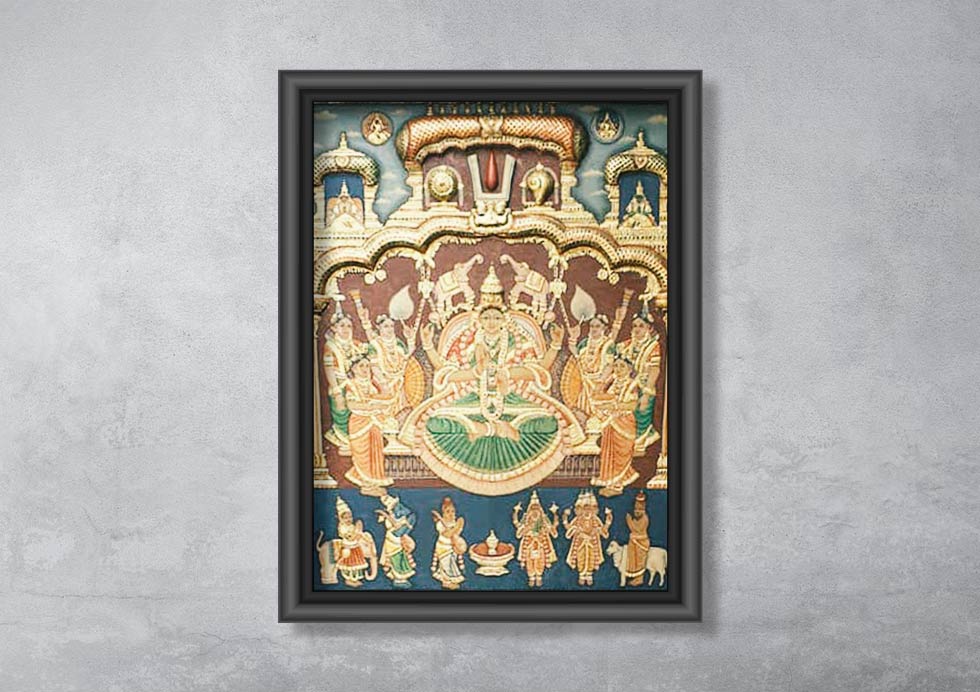
Tanjore painting, also known as Thanjavur painting, is one of the most cherished art forms originating from South India. Its vibrant colors, rich surface, compact composition, and surface richness have captivated art lovers for centuries. Named after the city of Thanjavur in Tamil Nadu, Tanjore paintings are synonymous with the grandeur and elegance of South Indian royalty.
The origin of Tanjore paintings dates back to the 16th century during the reign of the Nayakas of Thanjavur. The art form flourished under the patronage of the Maratha rulers who took over the region in the 17th century. The Maratha influence brought a unique blend of styles, incorporating elements of Deccani, Vijayanagara, and European painting techniques. Over time, Tanjore paintings became a hallmark of devotion, often depicting Hindu gods and goddesses, saints, and episodes from religious texts.
Unique Features
One of the most striking features of Tanjore paintings is the use of gold leaf. The Tanjore Artists meticulously apply layers of gold foil to create a stunning effect, making the paintings glow with a divine light. This technique, along with the use of vibrant colors and intricate detailing, sets Tanjore paintings apart from other Indian art forms.
The central figure in Tanjore paintings is usually a deity, painted in rich, bright colors and adorned with jewelry. The figures are often plump and have almond-shaped eyes, which are characteristic of this style. The background is typically flat and painted in bold colors, providing a stark contrast to the detailed central figure.
The Making Process
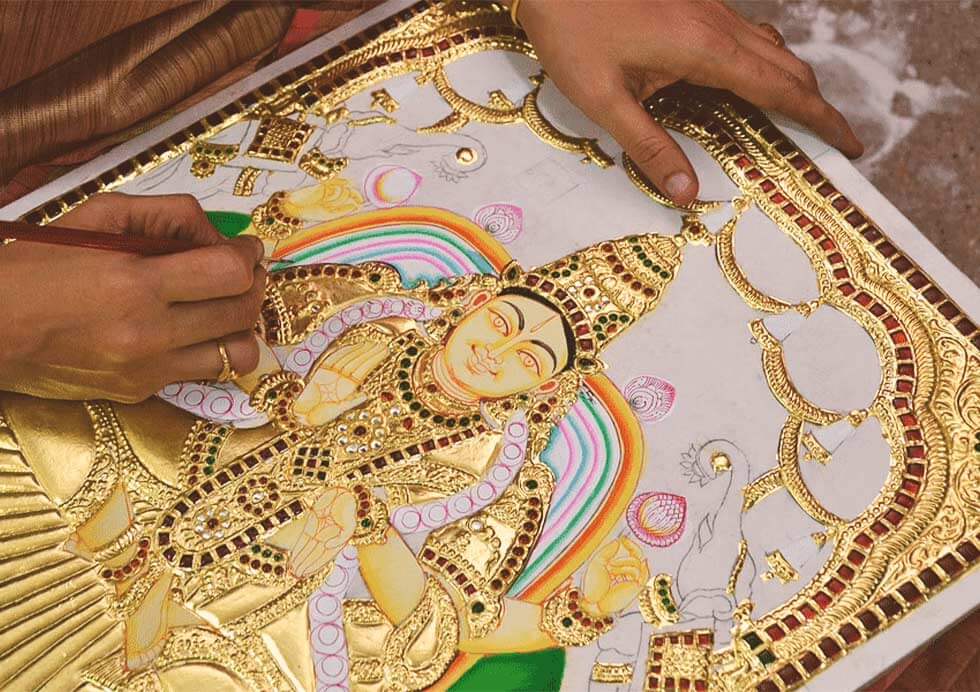
Creating a Tanjore painting is a meticulous and labor-intensive process. It involves several stages, each requiring great skill and precision.
Preparation of the Board: Traditionally, Tanjore paintings were made on wooden planks. Nowadays, artists also use canvas mounted on plywood. The surface is coated with a mixture of chalk powder and a binding agent, usually Arabic gum. This is followed by a smoothening process to create an even surface for painting.
Sketching: The artist then sketches the outline of the image on the prepared board. This step requires a steady hand and an eye for detail, as the sketch forms the foundation of the painting.
Gesso Work: To create a raised effect, artists apply a paste made from limestone and a binding agent on specific areas of the sketch. This gives the painting its characteristic relief effect, particularly on jewelry and other embellishments.
Gold Leaf Application: Thin sheets of gold leaf are carefully applied over the gesso work. This step requires precision to ensure that the gold adheres perfectly to the raised areas, giving the painting its unique shine.
Painting: Once the gold leaf is in place, artists begin painting the image using natural dyes and vegetable colors. The colors are chosen to complement the gold, creating a vibrant and harmonious composition.
Final Touches: The final step involves adding intricate details, such as facial features, clothing patterns, and fine jewelry. This brings the painting to life and showcases the artist's skill and creativity.
Preparation of the Board: Traditionally, Tanjore paintings were made on wooden planks. Nowadays, artists also use canvas mounted on plywood. The surface is coated with a mixture of chalk powder and a binding agent, usually Arabic gum. This is followed by a smoothening process to create an even surface for painting.
Sketching: The artist then sketches the outline of the image on the prepared board. This step requires a steady hand and an eye for detail, as the sketch forms the foundation of the painting.
Gesso Work: To create a raised effect, artists apply a paste made from limestone and a binding agent on specific areas of the sketch. This gives the painting its characteristic relief effect, particularly on jewelry and other embellishments.
Gold Leaf Application: Thin sheets of gold leaf are carefully applied over the gesso work. This step requires precision to ensure that the gold adheres perfectly to the raised areas, giving the painting its unique shine.
Painting: Once the gold leaf is in place, artists begin painting the image using natural dyes and vegetable colors. The colors are chosen to complement the gold, creating a vibrant and harmonious composition.
Final Touches: The final step involves adding intricate details, such as facial features, clothing patterns, and fine jewelry. This brings the painting to life and showcases the artist's skill and creativity.
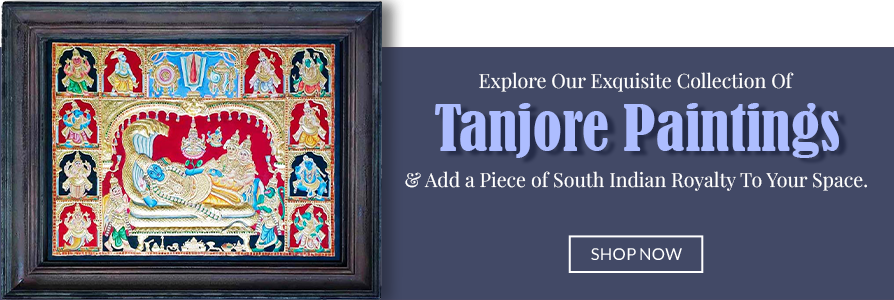
Themes and Subjects
Tanjore paintings predominantly feature Hindu deities, with Lord Krishna, Lord Rama, Goddess Lakshmi, and Lord Ganesha being popular subjects. Scenes from epics like the Ramayana and Mahabharata, as well as stories from Puranas, are also commonly depicted. Apart from religious themes, Tanjore paintings sometimes portray royal figures, saints, and even occasionally European figures introduced during the colonial period.
Cultural Significance
Tanjore paintings are more than just decorative pieces; they hold immense cultural and spiritual significance. They are often used in rituals and placed in homes as objects of worship. The gold leaf and vibrant colors are believed to bring prosperity and positive energy. Over the centuries, modern Tanjore paintings and traditional ones have become an integral part of South Indian culture, representing the region's rich artistic heritage.
Preservation and Revival
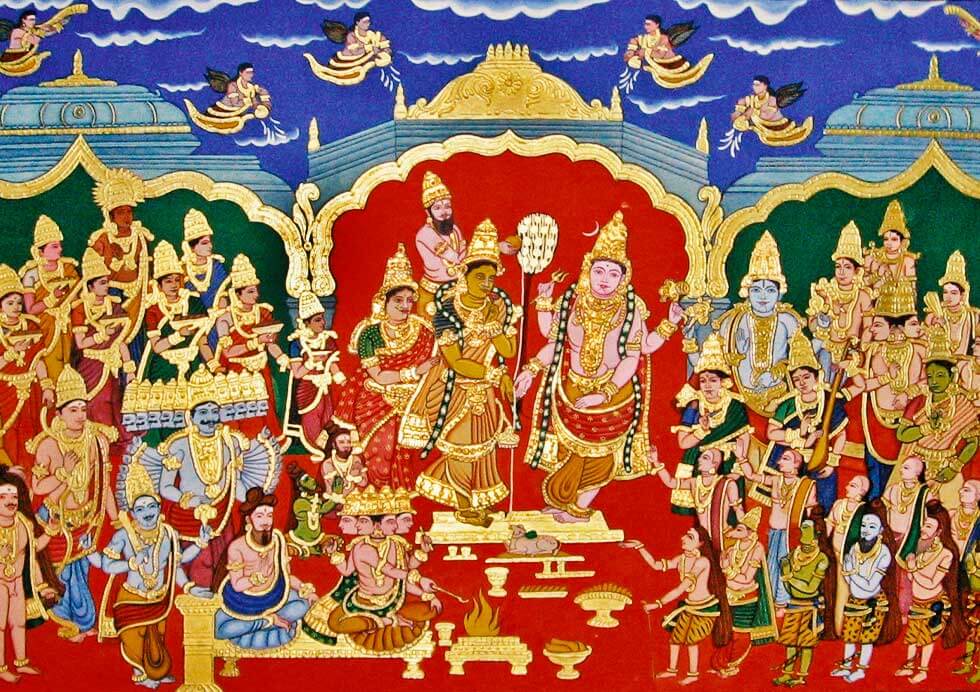
The art of Tanjore painting faced a decline in the early 20th century due to the advent of modern art forms and changing tastes. However, efforts by art historians, cultural organizations, and dedicated artists have led to a revival of this exquisite art form. Today, modern Tanjore paintings are celebrated not only in India but also internationally. Workshops, exhibitions, and online platforms have helped in spreading awareness and appreciation for this traditional art.
Collecting Tanjore Paintings
For art collectors, owning a modern Tanjore painting is a matter of pride. Authentic Tanjore paintings are highly valued and can be quite expensive. When purchasing a Tanjore painting, it is essential to look for certain features that denote authenticity, such as the use of real gold leaf, natural colors, and the characteristic relief work. Reputable galleries and certified artists are the best sources for acquiring genuine pieces.
Conclusion
Tanjore painting is a testament to the rich cultural tapestry of South India. Its intricate designs, vibrant colors, and the opulent use of gold make it a unique and treasured art form. By preserving and promoting Tanjore painting, we not only keep alive a significant aspect of our artistic heritage but also inspire future generations to appreciate and continue this magnificent tradition. Whether displayed in homes, temples, or art galleries, Tanjore paintings continue to mesmerize and evoke a sense of awe, just as they did in the royal courts of Thanjavur centuries ago. You can buy Tanjore Painting online at cottage9.com.
In celebrating Tanjore painting, we celebrate the timeless beauty and spiritual essence that this art form embodies. It is a reminder of the rich artistic legacy that India offers to the world and a call to cherish and preserve it for posterity.

